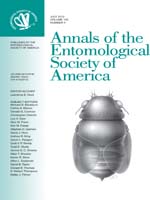Many North American sesiid moths within Synanthodonini have been studied extensively because their feeding activity can cause detrimental economic and esthetic impacts to many commercially important ornamental and native plant species. Recent discoveries of nonnative clearwing moth pest introductions [e.g., Synanthedon myopaeformis (Borkh.)], reinforce the need for reliable and accurate molecular diagnostic tools that can be used by nontaxonomic experts, particularly when juvenile life stages are recovered from infested host-plant tissues. Cytochrome oxidase I (cox I) previously has been used to successfully identify species and resolve species complexes. In this study, the cox I phylogeny inferred from sequences generated from 21 species of sesiid moths classified within Synanthedonini confirms the close evolutionary relationship between sesiid species. As other authors have suggested in previous works, we observed that Synanthedon rileyana H. Edwards appears atypical for the genus, as it paired with Carmenta bassiformis (Walker) one node removed from, but not sister to, a large well-supported Synanthedon-rich clade. Sannina uroceriformis Walker and Podosesia Möschler were observed nested deeply within the aforementioned well-supported clade (posterior probability [PP] of clade = 100) comprised of all Synanthedon species sampled, except S. rileyana. Placement of these two taxa conflicts with results from previous morphological studies. These placements were immune from repeated attempts to delete perceived nearby long branches within the data set. Despite these few conflicts and overall low statistical support for most interspecific and higher relationships, our data suggest that all species examined possess unique genetic signatures that lend themselves to accurate identification of all life history stages of these clearwing pests.
How to translate text using browser tools
1 July 2012
Molecular Identification of Synanthedonini Members (Lepidoptera: Sesiidae) using Cytochrome Oxidase I
J. A. Hansen,
W. E. Klingeman,
J. K. Moulton,
J. B. Oliver,
M. T. Windham,
A. Zhang,
R. N. Trigiano
ACCESS THE FULL ARTICLE
It is not available for individual sale.
This article is only available to subscribers.
It is not available for individual sale.
It is not available for individual sale.
barcoding
clearwing moth
DNA fingerprinting
Lepidoptera
woodborer





